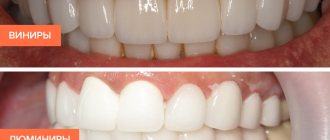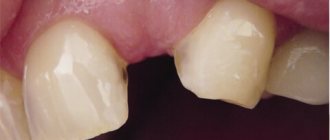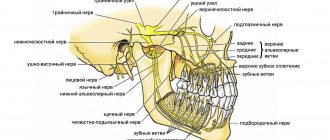01/22/2019 Modern dentistry offers various methods for correcting chips, cracks and other dental defects. One of the popular solutions is extension, which allows you to return the tooth to its original color and shape. What the procedure is and who it is suitable for - you will learn about this from our article.
- What is tooth augmentation?
- Indications and contraindications for the procedure
- Advantages and disadvantages of dental extensions
- Basic methods of filling
- Installation of veneers
- Installation of crowns
- Extension on a pin
When can a tooth be restored?
When the walls have completely crumbled, but the root of the tooth has not been destroyed, traditional dentistry sometimes suggests removing it. Today, using new protocols, it is possible to preserve the root and create a new stable unit - any of the functional ones, except for the “eights” (wisdom teeth). To do this, you need the root to be healthy:
- Not affected by caries, without fractures or cracks. If such defects exist, then only removal followed by implantation is indicated.
- No cyst. If there is one, then a method of treatment is selected. And only then can you begin to restore.
If a similar problem happens to you, do not rush to the surgeon. New technologies make it possible to accomplish the previously impossible - to preserve the root of a tooth. What to do in a particular case is decided at the appointment, after diagnosis. The vast majority of patients manage to save the tooth after treatment procedures and install a crown on the root of the tooth.
Indications and contraindications for the procedure
Extension is indicated in the following cases:
- Chips and cracks on the tooth surface.
- Destruction of enamel or its discoloration, which cannot be eliminated with bleaching.
- Partial tooth loss due to injury or caries.
- Malocclusion.
- Interdental gaps.
- Age-related wear of enamel, in which the dental unit darkens and becomes sensitive to external influences.
However, restoration is not suitable for every patient. It cannot be performed if one of the contraindications is present:
- Untreated caries or gum disease.
- Severe systemic diseases, such as blood diseases or diabetes.
- Some mental disorders.
- Bruxism.
- Bruxism. Individual intolerance to the components of the filling composite.
There are also technological limitations: if it is impossible to protect the restored surface from contact with moisture (for example, saliva), then the extension will have to be abandoned - the filling will not harden. Also, some methods cannot be used for dental treatment in children - for example, they do not have pins installed. For most patients, augmentation remains the optimal solution for restoring a lost tooth fragment.
Examples when only the roots of the teeth in the upper jaw remain
Example 1. Restoration from one root of a front tooth
In this example (presented in full here), the situation was created literally by the patient’s hands. She tried to glue part of the tooth with superglue and, under the influence of dangerous substances contained in the glue, the crown of the tooth became completely unusable.
But the root of the tooth under the crown below remained intact and unharmed.
The length of the healthy part of this tooth root removed all doubts about the question - is it necessary to restore the root? Certainly! - it is possible and necessary. The tooth was restored in 1.5 hours using Cerec technology. And here in the photo is the happy owner of a new restored front tooth:
Example 2. Restoring 3 front teeth, of which only the roots remain
Here is a treatment example where I restored the aesthetics of her smile to a 22-year-old girl. The three front teeth on the upper jaw were completely destroyed. From the upper teeth 1.2, 1.1, 2.1 only
the roots
:
These three teeth were actually an aesthetically unsightly frame made from old fillings. Now we will not analyze the whole case in detail, I would like to draw your attention to the following points:
- the shape of the roots of the teeth and their condition made it possible to restore them
- There was no talk at all about any amputation - removal of the roots of the teeth of the upper jaw and implantation.
Our patient's smile was designed in a computer program:
So, in the photo below you see a general set for restoring our patient’s dentition, and among the modules there are 3 with a crown and a root.
The roots of the upper front teeth were quickly and, most importantly, effectively restored:
and our patient underwent a beautiful transformation and became the owner of a sweet and chic smile:
This is the enormous potential and aesthetic power of healthy tooth roots! Don't rush to delete them)
Example 3. Complete restoration of the smile zone on the front teeth of the upper jaw
This example is actually very popular on the Internet, since the patient is a TV presenter, and as a result of the treatment she found her new smile. Which is extremely important for her profession. I describe the detailed clinical case itself in another article, but here I would like to note the main points related specifically to the restoration of the roots of the front teeth with crowns.
In the picture below we have removed composite restorations and carious lesions. only the roots remain of the two front incisor teeth.
:
Crowns and “crown + root” modules were prepared in the laboratory:
After installation, the smile began to shine with bright colors:
You can see the entire chronology of our patient’s treatment in one large picture, step by step:
Causes of dental chips
There are many circumstances that can lead to partial tooth destruction; among the most common, experts note the following:
- Injuries received by mechanical means, from which people who lead an active lifestyle or choose extreme sports are least insured (children jumping like saigas and teenagers fighting behind garages also fall into this category). Although, by and large, this reason is quite common, tooth damage can be caused by blows, falls, accidents, which, unfortunately, happen every day.
- Demineralization of tooth enamel, lack of calcium, fluoride and other microelements necessary to strengthen teeth are typical for women during pregnancy and lactation, and the elderly.
- Weakening of enamel due to overuse of sweet or sour foods, viscous and hard foods, exposure to high and low temperatures is at risk for those with a sweet tooth, especially those who like to drink ice cream with hot coffee.
- Carious lesions of the enamel of dental tissue, which can penetrate to the very root and significantly reduce the strength of the tooth, making it fragile and unstable even to small loads.
- An incorrect bite that disrupts the balance of stress on the dentition, which can lead to the abrasion of enamel and the appearance of areas with exposed dentin.
- Disturbed hormonal metabolism, weakened immunity, poor heredity.
- Bad habits, such as heavy smoking, the habit of cracking nuts with your teeth or opening beer bottles with your teeth like a hussar.
- Poor installation of the seal or its destruction.
Child's tooth chipped
Why do tooth remains appear in the gums?
There are many reasons for this phenomenon:
- Perhaps the tooth has completely crumbled, but the root remains.
- The crown received a strong blow and a fracture occurred.
- An incomplete tooth extraction was performed. The remaining fragments cause inflammatory processes in the soft tissues, causing pain.
- Units with the neurovascular bundle removed are often destroyed. The so-called “dead teeth”. The nutrition of their walls is disrupted, the shell becomes fragile and, due to incorrect loading or due to increased fragility, the natural walls break off “at the root.”
If the process has already started, then urgent treatment of the tooth root is necessary. Otherwise, the remains of the unit will have to be removed to avoid infection of adjacent teeth and surrounding tissues.
The situation cannot be ignored: tooth fragments may not bother you at first, but then turn into a serious problem. When trouble occurs, immediately contact the dental clinic to promptly select treatment and find ways to restore the tooth.
What can happen if treatment is not started on time?
For some, it may seem that a chipped tooth is not such a serious defect to pay attention to it; for some people, the aesthetic component and beauty of a smile does not play a significant role, while others are willing to endure such inconveniences as increased tooth sensitivity only would not visit the dentist. However, if you ignore the problem, it can lead to more serious consequences:
- The appearance of carious lesions with damage to dentin and the formation of cavities in the tooth. In advanced cases, caries is complicated by pulpitis and periodontitis. The affected tissue not only causes severe pain, but also leads to extensive destruction, including tooth loss.
- Development of cysts and granulomas
- Displacement and shifting of the dentition due to curvature of the roots or changes in the angle of inclination of the root; the most harmless thing this can lead to is malocclusion.
The occurrence of caries at the site of tooth damage
Most of these diseases are quite difficult to treat, so you should respond promptly to emerging oral problems and not neglect medical care, so as not to become a regular client of the dentist.
Examples of canine restoration when only the root remains of the tooth
Example 4. The pin in the root of the lower tooth was removed, and the canine itself was restored
In this clinical case, I was restoring the lower canine, and the task was to save the root of the tooth and restore the coronal part of the canine, which was almost destroyed by caries. The anterior wall of the lower canine was made in the form of a filling, and it fell apart from the cutting edge.
As you can see in the photo, an anchor pin was installed inside the tooth - this is a pin that is screwed into the canal to strengthen the tooth. The tooth under the filling and the root of the lower canine were affected by caries. When the carious tissue was removed, only the root and a small part of the wall
:
You and I remember the main topic of our article, which tells us the following - if the tooth root remains, it can be completely restored. And this is not the first time that the unique Cerec technology has come to our aid. Using it and digital scanning, we restored the missing tooth module, which also included the root part:
Next, we restore the lower front tooth using a CEREC inlay and get an excellent result - the lower canine is completely restored:
Example 5. The root of the tooth under the crown of the upper canine has not rotted, and therefore the tooth is 100% restored
In this case, there was a total restoration of the dentition (veneers and crowns) with the replacement of worn-out crowns on the front teeth. One of the upper canines under the crown was seriously affected by caries, but its root was practically healthy - only a small part of the tooth root was damaged, see the following photo:
The missing “crown + root” module and new crowns were manufactured in a laboratory. In general, everything is in a smile, it looks just great:
And the owner of a new beautiful smile herself cannot hide her admiration:
All the main tasks in this total work were successfully solved, but the main thing you should pay attention to is that we managed to save the tooth root here too.
Choosing a teeth extension technique
You can choose the optimal method of tooth extension only after consulting a dentist. The doctor will assess the degree of destruction of the dental unit, check the safety of the root and nerve, and depending on this, recommend a suitable method of restoration.
For example, veneers or lumineers are most often used to restore minor damage to incisors and canines. They hide visual defects, straighten the dentition, and return lost whiteness to the unit.
If the hard tissues of the tooth are seriously damaged, then you should resort to crowns or extensions to a pin. In this case, you can completely restore the unit and return it to functionality.
When consulting with a dentist, you need to clarify:
- The service life of the restored tooth, its resistance to wear, food coloring, and the possibility of restoration in the event of a chip. For example, some crowns can be repolished if minor defects appear; reinstallation of the microprosthesis is not required.
- The number of procedures for which it will be possible to grow a tooth. The fastest options are filling and installation of lumineers. Other technologies will require multiple visits to the clinic.
- Tissue healing rate. Some augmentation methods allow you to restore a tooth without damaging the gums. This guarantees the patient minimal discomfort after the procedure.
Different types of extensions differ in price, which must be taken into account when choosing a technique.
How to determine if a root is healthy
How to understand whether caries has affected the root of the tooth, whether the dentin of the tooth root is intact or whether there are defects? In order to have an objective picture of the process, it is necessary to perform an x-ray of the tooth root and a computed tomogram. A CT scan will determine the true condition of the root and show:
- The presence of inflammatory processes.
- It will determine whether there are neoplasms and what size they are (cyst or granuloma).
- The location of the roots in relation to the neighboring ones, the maxillary sinus.
This is the only way to see whether it will be possible to cure the tooth root using a tab.
Example 6. Restoration of teeth 4 and 5, when only one root remains
In the next total work I would like to highlight the 4th and 5th premolars. In general, the girl’s situation was quite complicated initially at the time she contacted me. Both the lower and upper jaws were restored. Let's look at only the top one.
Front 4 teeth
- these are 1.2, 1.1, 2.1 and 2.2 were entirely made of composite material, under which caries developed. And the teeth we were interested in, 1.4, 1.5, 2.4 and 2.5, were covered with metal-ceramic crowns under which there were metal inlays. Today, such structures are rarely used in advanced dentistry, since the same Cerec technology allows you to achieve excellent results with one module “crown + tooth root”, rather than breaking the structure into an inlay and a crown with an additional adhesive layer. In fact, we place a crown at the root of the tooth with the function of the missing root. There will be a separate example on metal tabs a little later.
So, in the photo below, the crowns were removed, the inlays were removed and carious tissue was removed from teeth 4 and 5, leaving healthy roots
:
If only the root remains of a tooth, this does not mean that it cannot be restored. And let this tooth root be pulpless, i.e. dead - such tooth roots feel great in bone tissue and orthopedic structures can be built on them. Using computer technology and 3D scanning, we first restored virtual teeth:
The following photo shows that on one side we place crowns with an inlay function in place of the 4th and 5th teeth, and on the other opposite side we place half-crowns also with an inlay function.
That is, these are single modular designs - veneers with a root part, which are currently the best for the patient
:
Installing veneers with the root part allows you to completely recreate an aesthetically beautiful dentition:
The stage of temporary prosthetics, which allows the patient to see his smile, plays an important role in the very process of its new formation, since the patient understands that the main problems with the restoration of the remaining teeth, and in fact the roots of the teeth, are left “far behind”:
After installing crowns and half-crowns and restoring the front teeth, our patient’s smile was transformed beyond recognition, the so-called. wow effect:
The clinical example described above can be viewed in detail HERE.
Why removing the root is not the solution to the problem
If there is no natural crown, and instead of it an empty space appears, especially when it is the roots of the upper front teeth, many people habitually rush to the surgeon. They want to remove the remains and quickly install a bridge, eliminating the aesthetic defect.
But first, it’s worth considering the situation with your doctor - there are certain risks during removal: damage to the mandibular nerve, excessive trauma to the gums, and others. In addition, tooth restoration based on its own root is always more gentle than any prosthetic method.
Dentists try to preserve every unit, since the absence of natural teeth leads to a decrease in the quality of life. If you simply remove the roots of permanent teeth, then immediate implantation is needed. In the absence of a unit, destructive processes begin in tissues, and bone volume decreases. Therefore, doctors do not recommend neglecting this problem. Even if there is no chewing molar, which is not visible.
A child's baby tooth is chipped: do children get teeth augmented?
Children, due to their activity and curiosity, are susceptible to injuries, which can lead to the formation of chips on their teeth; in addition, in older children, the bite changes, single molars grow, which can lead to an uneven load on the milk teeth, which can lead to weakening of the enamel and the formation of cracks. Many adults mistakenly believe that such defects should not be treated, since baby teeth will fall out anyway.
If treatment for damage to baby teeth is not started in time, in addition to pain and increased sensitivity, the child may develop stomatitis, so it is necessary to visit a dentist in case of injury.
As a rule, the treatment of primary teeth occurs according to a simplified system in order to preserve temporary units before they fall out; antiseptic protective gels, fluoridation or installation of a temporary plastic filling are used to protect the tooth from further destruction.
Examples of restoration of fifth teeth on the upper and lower jaws
Example 7. A metal tab and caries left only the root of the 5th tooth
A patient came to me with a 3.5 tooth. It was a pulpless tooth - the lower five, it did not have any periapical changes or inflammation in the area of the root apex. The tooth was missing the upper half of the crown part of the tooth. This tooth 3.5 initially had a filling, a metal stump insert was installed in the tooth, quite deep, and a filling was already installed on top. Here's a “puff sandwich”:
As I said in the previous example No. 6, metal tabs are beginning to be used less and less in practice - they have been replaced by modern computer technologies, for example, Cerec. As a result of the atraumatic removal of the metal insert, the bone was preserved, nothing cracked: neither the root nor the remaining bone structure:
The restoration of the bottom five was carried out using Cerec technology in 1.5 hours
:
The “crown + root” module fell into place perfectly, the patient was very pleased with such a quick and effective solution to his problem:
Example 8. The top five were completely destroyed by caries. But the tooth root survived
With this example, I want to show you how deep caries can literally “eat” your teeth. And, of course, try to prevent it from developing like this. The patient is a fairly young man who has decided to radically improve his image. This is a laudable decision, but here are the teeth he came to me with:
Caries on almost all teeth. After removing the carious layer, the remains of the teeth appeared in this form:
Please note that in place of the upper tooth 5
There was practically only one root left with a small side wall. In this case, the same technology of tooth restoration using the “crown + root” module and crowns/half-crowns with an inlay function was used. The result of the treatment, as they say, is on the face:
The goal of treatment, according to the patient, has been fully achieved - a brutal Man
:
Types of damage and consequences of chips
Chip of tooth enamel or microcrack
As a result, the integrity of the upper dental layer is compromised, or its particles are separated. In most cases, such damage is barely noticeable and does not cause pain to the person; experts classify these defects as mild, and people prefer not to go to the dentist with such “nonsense.” However, places where the integrity of the enamel is damaged may be subject to various stresses, which provoke the development of pathogenic microflora, carious lesions and the activity of pathogenic microorganisms.
Vertical and horizontal cracks
Chipped tooth with dentin fracture
Considered to be a moderate injury. Such damage may not be accompanied by pain, or may cause discomfort and unpleasant sensations to external stimuli: hot or cold food, sour or sweet foods. Dentin is the inner tissue of the tooth and is inferior in strength to enamel, therefore, if the lost part is not built up in time, the dentin will begin to crumble, which can lead to tooth loss. From an aesthetic point of view, even a small chip in a front tooth can significantly reduce the attractiveness of your smile.
Deep fracture of the tooth to the pulp tissue with exposure of the nerve
This type of injury is considered the most severe, often accompanied by a split tooth into two parts, profuse bleeding and sharp pain, reminiscent of the torture of the Spanish Inquisition, and even painkillers only temporarily dull the pain. In such cases, delay can be fraught with inflammation and the development of infection.
When and how can you restore a tooth with Cerec?
A common problem is the development of caries on the frontal units. The result is their complete destruction. The patient sometimes comes too late. Or the previous intervention does not bring the desired result. When several units in the smile area are damaged, and some of them only have tooth root tissue left, you can combine the installation of crowns, veneers and restoration of the upper visible part using special inlays in the root system. Sometimes large-scale intervention is needed - the smile area is corrected, damaged teeth are recreated. You can do a step-by-step restoration of 10 or even 20 teeth above and below.
Using Cerec technology, if there is a healthy root, it is easy to restore almost every tooth within a few hours.
- It will be necessary to determine the condition of the root and undergo a course of treatment.
- Then, after treating the upper roots, it is possible to install a module with the alignment of the tooth crown and the insert into the cavity in the tooth root.
A smile should always be charming. When restored, the new units are ideal, better than natural ones. In addition, natural teeth darken under the influence of pigments or turn yellow with age. Therefore, next to the restored ones they look unaesthetic.
To avoid such consequences, units can be corrected with veneers or crowns (when they are 50% destroyed and there is no stable support). To create an impeccable beauty zone thanks to Cerec, you only need a few visits to the doctor.
Repairing chips on artificial teeth
Unfortunately, no one is immune from injury, so there is a possibility of damage to artificial teeth, for example, temporary metal-plastic crowns, ceramic products (in cases of high load on them) or metal-ceramic crowns. In such cases, the product can be polished, removed with subsequent repairs, or an artificial crown can be built up directly in the oral cavity using special materials - silane, opaque composition and a halogen lamp.
Polishing artificial teeth
Features of Cerec technology
Cerec root inserts and crowns are made from metal-free materials - it can be ceramic or zirconium dioxide. They can be installed even for allergy sufferers without fear. This technology has completely changed traditional approaches to dentistry.
Now the restoration process is comfortable and takes a minimum of time. In my clinic, the procedure is carried out in several stages.
I would also like to note that only one anesthesia is required and there are practically no errors when creating new teeth. Stages:
- An intraoral scanner determines the boundaries of the damage. This is especially important when only the roots of the front teeth or molars remain. The remaining tissues, antagonist teeth, and closed rows are scanned.
- The information is transferred to a computer, where all the images are combined into an image.
- The program creates a three-dimensional model of the remaining tooth, all defects are clearly visible. Then models of the inlay and crown are created that perfectly replicate the anatomical features of the tooth. Dimensions and shape are calculated accurately. It is determined what kind of restoration is needed.
- The design is made from blanks on a milling module. The elements are being tried on. In rare cases, correction is required. Shade discrepancies or other issues that displease the patient can be easily corrected within a few minutes.
- The completed root inlay fits hermetically to the remaining parts of the tooth, is securely fixed and exactly matches the shape.
Thus, it is possible to quickly restore units if only the roots of the teeth of the lower or upper jaw remain.
Benefits of Cerec Restoration
The innovation has clear advantages compared to traditional prosthetics:
- The process does not take a week or several days, but only 1.5 hours
per tooth maximum. - Accuracy
. The computer minimizes errors and eliminates errors. - Biocompatibility
. Fabrics do not reject materials.
An inlay in the tooth root is created quickly, then the crown is modeled. The price is fully justified by the reliability, long service life of the structures and their aesthetics.
There is a striking difference between the smiles of patients when they only had the root of the tooth left, and the photo after treatment with Cerec dentures.
Recommendations from experts
It is impossible to completely exclude the possibility of the formation of dental defects, but in order to minimize the risk of cracks and chips in the teeth, experts recommend following a few simple rules that will help strengthen tooth enamel and make it more resistant to mechanical damage:
- Pay close attention to your oral hygiene, don’t be lazy about brushing your teeth twice a day, and don’t shy away from using dental floss and mouthwash.
- If possible, limit yourself to consuming sugary edibles. Of course, many people love cakes, sweets and ice cream, but everything should be in moderation!
- Include in your daily diet foods rich in fluoride, calcium, phosphorus and vitamin C: natural milk, sour cream, kefir, fermented baked milk, cottage cheese, various types of cheeses, herbs and nuts.
- Visiting the dentist at least twice a year, a timely scheduled examination makes it possible to identify most oral diseases at an early stage.
Example 9. Restoring the bottom six “from the root”
In this case, I would like to simply dwell on the moment of restoration itself. The patient is older, over 50 years old. And he felt the need to restore the chewing group of teeth. The picture shows the lower 6th tooth, of which practically only one root remains:
The tooth was restored in 1.5 hours
using Cerec technology. The very speed of tooth restoration in one visit to the doctor and the patient’s ability to immediately, as they say, use it in chewing gives a 100% head start on any existing method of tooth restoration. It works really well - you can see for yourself.
Example 10. Restoring the bottom seven
And I end my examples with the classic option of restoring the seventh lower tooth, of which only the root part remains. Removal of the lower 7th root of the tooth was not required; Cerec technology again proved to be excellent:
After modeling in 3D, manufacturing the module itself only took about 20 minutes, after which it was successfully installed on the remaining root:
Should the tooth root be removed? In what cases is this necessary?
Is it necessary to remove the root of a tooth? The root must be removed if:
- it is mobile, unstable or has a deep pocket;
- there are cracks;
- the root processes are “recessed” into the bone tissue and are located below their level;
- root tissue is softened or severely destroyed;
- There are chips in the tooth root.
Modern surgery is as painless as possible. Doctors perform the procedure while maintaining the integrity of the surrounding tissue. In the absence of inflammatory processes, it is possible to remove the real tooth root with simultaneous implantation of an artificial one.
CONCLUSIONS:
As you can see from the examples provided, I, orthopedic dentist Sergei Samsakov, an expert in the field of digital modeling and restoration of teeth using Cerec, manage to restore a beautiful smile even in almost the most hopeless cases. If you have similar problems, do not hesitate, contact us, and we will always find the optimal and, most importantly, beautiful solution to your situation.
And remember the simple truth: there are no hopeless situations!











